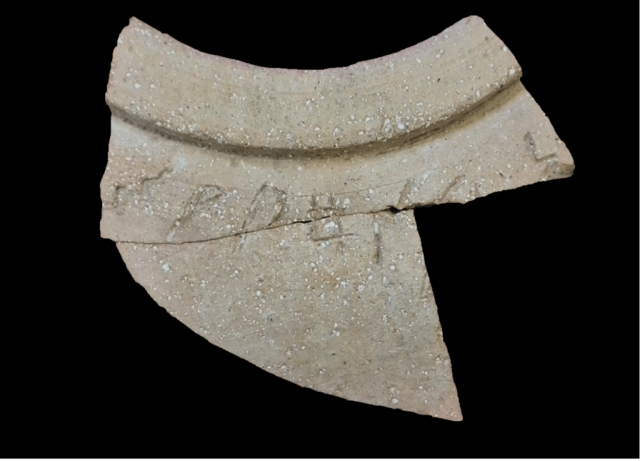As part of the Ofel excavations that began over a decade ago, a Sabaen inscription was deciphered on a clay urn, which contained remnants of incense, and was discovered less than 300 meters from the Temple Mount in Jerusalem. Researchers from the Hebrew University said that the inscription on the urn indicates a connection between the Israelite kingdom under the rule of King Solomon and the Kingdom of Sheba. Sabaen is an ancient language from the southern Arabian peninusla.
In excavations conducted in 2012 in the Ofel area of Jerusalem, on behalf of the Institute of Archeology of the Hebrew University headed by the late Dr. Eilat Mazar, the remains of seven large clay pots were discovered and on the neck of one of the pots was engraved an inscription that was partially preserved. The inscription was dated by Dr. Mazar to the days of King Solomon, that is to say, roughly 3,000 years ago. Only seven letters survived from the original inscription.
A Sabaean inscription on a large clay jar deciphered and discovered near the site of the Jerusalem Temple The Inscription Points to the Connection Between Israel Under the Reign of King Solomon and the Kingdom of Sheba #archaeology #Bible https://t.co/8lPAUeEYcJ pic.twitter.com/oAeq49kj6t
— Popular Archaeology (@populararch) April 3, 2023
Over the years, more than ten researchers have proposed different solutions, without reaching an agreed reading. The common denominator for all of them was the identification of the inscription as written in a Canaanite script, a script from which the ancient Hebrew used in the early days of the First Temple developed.
However, in a new study, published Monday afternoon in the journal of the Hebrew University's Institute of Archeology, the epigrapher Dr. Daniel Vainstub was able to decipher that it is an ancient Arab script, which was used at the time in the southern half of The Arabian peninsula. This is the area where present-day Yemen is located, and in the past, according to the researchers, the kingdom of Sheba, which was the dominant kingdom of the time, ruled those lands.
"Deciphering the inscription on the urn teaches us not only about the presence of speakers who came to Israel during Solomon's time but also about the geopolitical relationship, at that time, in our region. Especially in light of the place where the urn was discovered, an area known for being the center of the administrative activities of King Solomon and Jerusalem," said Dr. Vainstub. "This is further evidence of the extensive commercial and cultural ties that existed between Israel under King Solomon and the Kingdom of Sheba."
The researchers added that it appears that the clay urn was made in the vicinity of Jerusalem and the inscription on it was engraved before it was put into the kiln for firing by a person speaking in Sabaen, who was connected to the supply of medicinal incense, used often for religious ceremonies by the ancient Israelites.
The queen of Sheba prepared hard questions to ask King Solomon, in order to weigh his wisdom. The queen had not only presented the best of what she had, but also yielded all her heart to the wisdom of the king while they communed. #TheHeavenlyScroll#WorshipConference
— Am💜r (@Kath3rynAmor) April 2, 2023
At the time when the urn was created, the kingdom of Sheba flourished among other things on the basis of growing and marketing perfume and incense plants. Its capital was Marib. The Shebaites developed advanced methods of dams and irrigation of fields growing the bushes from which they produced perfumes and incense ingredients. Their language was a South Semitic language. From the descriptions in the Bible, it can be understood that King Solomon controlled the trade routes in the Negev, through which the Shebaite camel caravans passed, loaded with perfumes and incense plants, on their way to the Mediterranean ports for export.


